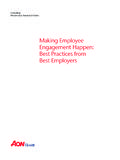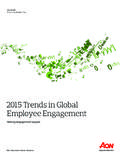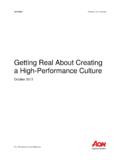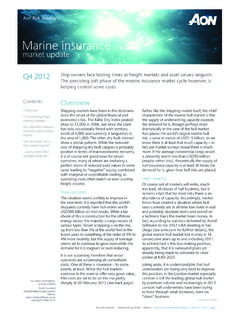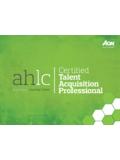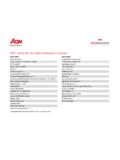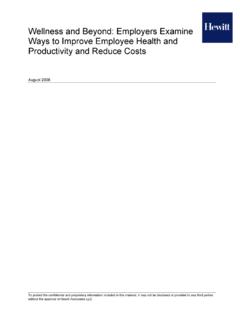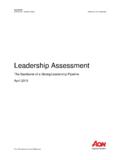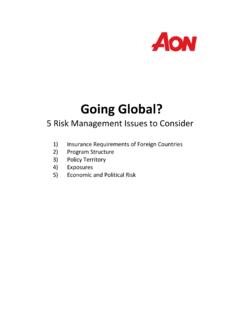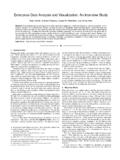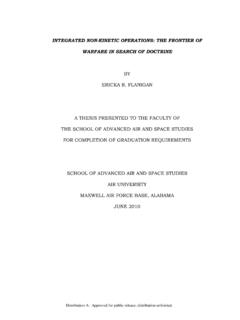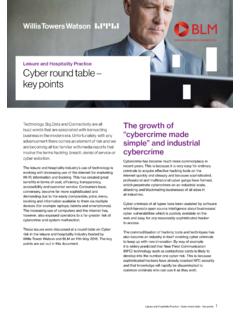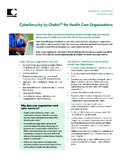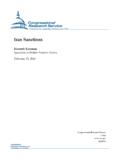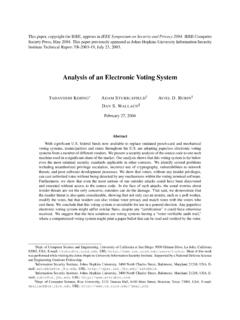Transcription of January, 2018 State of the U.S. Construction Industry
1 January, 2018. State of the Construction Industry Welcome In this Issue The United States Federal Emergency Management Agency (FEMA) declared 137 disasters in 2017. Tragically, as a result of these disasters, many lives were lost and thousands of people continue to struggle with their lives disrupted. 01 Welcome As we move into 2018, we hope for a full recovery for those displaced from their homes and businesses. The Construction Industry will play a major role in rebuilding both residences and critical infrastructure, and insurance will play a significant 02 State of the Market Update role in funding the recovery from those losses as well as insuring that work. 07 Outlook for Natural Fortunately the traditional insurance market and alternative risk capital sources remain well capitalized, demonstrating Catastrophes - Considering durability.
2 Indeed, the Insurance Information Institute recently reported that despite the catastrophic losses, policy- holder surplus has reached an all-time high of nearly $720 Billion. Consequently, they calculate the Industry as having the Aftermath close to the strongest claims paying status in history." Given that insurance availability and pricing are forecast to be relatively stable, pricing and possible deductible increases are anticipated for property exposed to natural catastrophe 09 Sustainability of the loss; however, no dramatic wholesale market increases are expected. Non-natural catastrophe loss results, both realized Construction Industry and anticipated, including automobile liability, frame fires, Construction defects, sub-contractor default, design and technology, social engineering, cyber, and employment practices, may also have a modest impact on the marketplace.
3 11 Cyber Risk in Construction However, any changes should be measured and targeted, given the ample available capacity and steadily improving 12 An AON Solution Spotlight analytics used in underwriting. In short, any corrections are expected to be much more targeted and less reactionary than in the past. Realizing the insurance market has at times severely and broadly corrected in response to mega-catastrophes ( , as it was post-9/11) or engages in targeted pricing increases ( , as in New York due to Labor Laws), the best Construction firms continue to utilize sophisticated risk management tools to help them protect their balance sheet and optimize margin over a sustained time period, while continuing to innovate. A recent McKinsey study, Reinventing Construction through a Productivity Revolution, suggests the global Construction Industry has a $ trillion productivity capture opportunity through: reshaping regulation, rewiring the contractual framework to reshape Industry dynamics, rethinking design and engineering processes, improving procurement and supply-chain management, improving onsite execution, infusing digital technology, new materials, and advanced automation, and reskilling the workforce.
4 As the Industry leader in Construction Risk Advisory and Brokerage Services, Aon has worked closely with clients to engage in advanced holistic risk practices and is poised to join them on their productivity journey. We have built a platform that empowers organizations to take on risk in ways that create economic growth, and enables people and firms to recover and thrive in the face of adversity. Only deep Industry insights, founded upon relevant data and analytics, can truly help reduce the volatility in an Industry challenged with an increasingly interconnected set of risks and solutions. This is central to our value proposition and systems, and Aon is committed to ensuring the Industry is aware of these core dynamics. We believe systemic risk trends in three major areas will ultimately shape new realities for all firms in the Construction space.
5 These can be broadly categorized as: 1) Regional, Political, & Economic Risk; 2) Macro, Global, & Workforce Trends; and 3) Delivery Methods, Innovation, & Technology. As the Construction Industry moves forward in these new frontiers, Aon is acutely aware of the changing headwinds and prepared to help our clients capture the opportunities that lie ahead. With that in mind, we present our outlook for 2018, a high-level perspective on Construction risk transfer in 2018 and a narrower look at the effects of natural catastrophes, Construction Industry sustainability, and cyber risk. We hope that the insights provided here will continue to impart additional perspective to the reader, exemplifying the scope of our proficiency and the comprehensive nature of our solution sets. Respectfully, Matt Walsh Market Observations back | home | forward State of the Market Update*.
6 Losses arising from natural disasters in 2017 were among the highest ever recorded. Total global economic cost was USD344 billion dollars as insurers covered USD132. billion of that total. Nine of the ten costliest insured loss events in 2017 impacted the continental United States. The predominant driver of damage resulted from one of the costliest Atlantic hurricane seasons on record, following the landfalls of Hurricanes Harvey, Irma, and Maria that left extensive damage across parts of the United States and the Caribbean Islands. Those three storms alone caused an estimated USD220. billion in damage and represented 62 percent of 2017's annual economic loss. Other significant events during the year included the Construction firms must examine their vulnerability, most destructive wildfire outbreak ever recorded taking stock of the full picture, including labor Nine of the ten costliest for the State of California in the United States.
7 The options, supply chain diagnostics, and financial insured loss events in 2017 October outbreak caused nearly USD13 billion in consequences. impacted the continental economic damage across Northern California's Napa Even through these challenging times, capital United States. Valley region and was followed by another billion- remained healthy. Global reinsurer capital was a dollar wildfire outbreak in Southern California in record USD600 billion at the end of third quarter December. It is worth noting that the insurance 2017. This is a broad measure to detail how much Industry was well positioned to handle the cost of capital insurers had available to trade risk, and also the 2017 disasters. ensured that both insurers and reinsurers were The current market remains stable and is not imposing capable of withstanding the extensive losses of the material changes except for projects that are located previous year.
8 In high catastrophic areas ( , Named Windstorm, For additional reports and outlooks on the Flood and Earthquake). For these risks, the market reinsurance market, visit Aon Benfield's Thought may impose higher deductibles, lower sub limits, and Leadership site a focus on the engineering and susceptibility of the project during the critical path and storm seasons. * Statistics and information in this section of the report called " State of the Market Update". were cited from Aon's Weather, Climate & Catastrophe Insight 2017 Annual Report. State of the Construction Industry | January 2018 2. Market Observations back | home | forward CASUALTY. 3 Overall, the market for Construction remains competitive. While market competition and capacity remain abundant, the deterioration of underwriting results is evident in certain general liability portfolios.
9 Long term 2 4 Construction underwriters with challenged portfolios continue to rebalance their business mix with changing coverage, deductible, premium and risk selection strategies. Generally, competitive alternatives are available for most insureds that demonstrate favorable loss histories and a commitment to disciplined loss 1 5 control strategies. 1 Highly Favorable 4 Mildly Unfavorable Poor underwriting performance in automobile coverage is a continued macro trend across the general 2 Favorable 5 Unfavorable 3 Fair/Average insurance marketplace. Most portfolios are realizing loss pressure, and larger fleets will likely be impacted by both primary rate increases and higher excess liability attachment points. The spike in losses stems from a host of interrelated issues, including increased mileage due to lower fuel cost, higher employment, continued use of communication devices (notably texting), rising healthcare costs, and the increased cost to repair Casualty Commentary Rating vehicles with increasingly sophisticated electronic Overall While market competition and Fair/Average components.
10 Due to a frequency of high severity in Market capacity remain abundant, the deterioration of underwriting the automobile line, insurers are focusing on results is evident in certain general liability portfolios. carefully underwriting large fleets and may put pressure on insureds to raise attachment points. Capacity and Market competition and capacity Mildly Pricing remain abundant, however, the Unfavorable deterioration of the Auto Market Driven by Labor Law claims, New York Construction and New York's vertical Construction environment will continue to liability remains a challenging line, most notably for challenge underwriting results. vertical Construction . But the Construction market in Losses Due to a frequency of high severity Mildly New York is very robust, so firms are focusing on in the automobile line, insurers are Unfavorable focusing on carefully underwriting aggressive and creative risk retention, loss prevention, large fleets and may put pressure on and risk transfer mechanisms to ensure they can insureds to raise attachment points.
